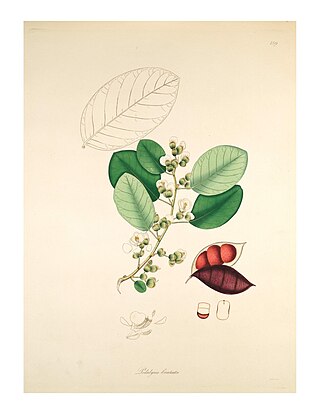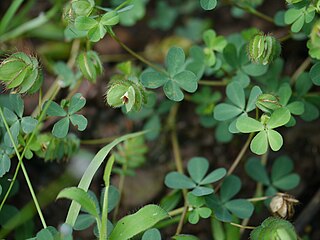
Styphnolobium is a small genus of three or four species of small trees and shrubs in the subfamily Faboideae of the pea family Fabaceae, formerly included within a broader interpretation of the genus Sophora. It was recently assigned to the unranked, monophyletic Cladrastis clade. They differ from the genus Calia (mescalbeans) in having deciduous leaves and flowers in axillary, not terminal, racemes. The leaves are pinnate, with 9–21 leaflets, and the flowers in pendulous racemes similar to those of the black locust. Necklacepod is a common name for plants in this genus.

Pickeringia is a monotypic genus of flowering plants in the legume family, Fabaceae. It was recently assigned to the unranked, monophyletic Cladrastis clade. It was named after the naturalist Charles Pickering. Its only species is Pickeringia montana, which is known by the common name chaparral pea. It is endemic to California in the United States, where its distribution extends along the Coast Ranges to the Peninsular Ranges, as well as along the Sierra Nevada foothills. It is also known from Santa Cruz Island.

Camoensia is a genus of 2 species of lianas in the family Fabaceae, subfamily Faboideae, native to the Gulf of Guinea, Africa. C. scandens is cultivated as an ornamental plant; it has one of the largest leguminous flowers, up to 20 cm across. The genus has classically been assigned to the tribe Sophoreae, but was recently assigned to its own monophyletic tribe, Camoensieae, on the basis of molecular phylogenetic evidence. Species of Camoensia are known to produce quinolizidine alkaloids, consistent with their placement in the genistoid clade.

Chapmannia is a genus of flowering plants in the family Fabaceae. It contains seven species with a scattered distribution – Mexico, Guatemala, Florida, and Venezuela in the Americas, and Somalia and Socotra in eastern Africa. The genus was recently assigned to the informal monophyletic Pterocarpus clade of the Dalbergieae.

Amphimas is a small genus of flowering plants in the legume family, Fabaceae. It belongs to the subfamily Faboideae. It is a west African tree used for medicine and for wood. Amphimas was traditionally assigned to the tribe Sophoreae; however, recent molecular phylogenetic analyses reassigned Amphimas into an unspecified position in the Meso-Papilionoideae.

Brya is a genus of flowering plants in the legume family, Fabaceae. It includes seven species of shrubs or small spreading trees native to Cuba and Hispaniola in the Caribbean. It belongs to the subfamily Faboideae, and was recently assigned to the informal monophyletic Pterocarpus clade of the Dalbergieae. Species include Brya ebenus, a valuable timber tree.

Cranocarpus is a genus of flowering plants in the legume family, Fabaceae. It includes three species native to northern and eastern Brazil. It belongs to subfamily Faboideae, and was recently assigned to the informal monophyletic Pterocarpus clade of the Dalbergieae.

Dalhousiea is a genus of flowering plants in the legume family, Fabaceae. It belongs to the subfamily Faboideae. It includes two species, one native to central Africa, and the other to eastern India, Bangladesh, and Myanmar.
Pterocarpus dubius is a species of flowering plant in the family Fabaceae native to Venezuela, Guyana, and northern Brazil in northern South America.
Fiebrigiella gracilis is a species of flowering plants in the legume family, Fabaceae. It is the only member of the genus Fiebrigiella. It belongs to the subfamily Faboideae, and was recently assigned to the informal monophyletic Pterocarpus clade of the Dalbergieae. It is a subshrub native to Ecuador, Peru, and Bolivia.

Geissaspis is a genus of flowering plants in the legume family, Fabaceae. It contains one accepted species, Geissaspis cristata. It is a scrambling annual or perennial which ranges from the Indian Subcontinent through Indochina to southern China and Peninsular Malaysia. It has three varieties:

Hymenolobium is a genus of flowering plants in the legume family, Fabaceae. It includes 14 species of trees native to Central America and northern South America, ranging from Honduras to Bolivia and southeastern Brazil. Most species are native to Brazil, the Guianas, and Venezuela, with one extending into Peru, another into Ecuador, and one native to Central America. Trees are typically very tall and emergent in tropical humid lowland rain forest.
Leucomphalos is a genus of flowering plants in the legume family, found in west Africa. It belongs to the subfamily Faboideae. Leucomphalos was traditionally assigned to the tribe Sophoreae; however, recent molecular phylogenetic analyses reassigned Leucomphalos to the Baphieae tribe.
Panurea longifolia is a species of flowering plants in the legume family, Fabaceae. It belongs to the subfamily Faboideae. It is the only member of the genus Panurea.
Ramorinoa girolae is a species of flowering plant in the legume family, Fabaceae. It belongs to the subfamily Faboideae, and was recently assigned to the informal monophyletic Pterocarpus clade within the Dalbergieae. It is the only member of the genus Ramorinoa. Unlike most legumes, Ramorinoa girolae does not produce any leaves.
Soemmeringia semperflorens is a species of flowering plants in the legume family, Fabaceae. It belongs to the subfamily Faboideae, and was recently assigned to the informal monophyletic Dalbergia clade of the Dalbergieae. It is the only member of the genus Soemmeringia.

Vatairea is a genus of flowering plants in the legume family, Fabaceae. It belongs to the subfamily Faboideae. It was traditionally assigned to the tribe Dalbergieae, mainly on the basis of flower morphology; recent molecular phylogenetic analyses assigned Vatairea into an informal, monophyletic clade called the "vataireoids".
Amphiodon effusus is a species of flowering plant in the family Fabaceae. It is found in non-flooded areas of the Amazon rainforest. It is the only member of the genus Amphiodon.
Cristonia is a genus of flowering plants in the family Fabaceae. It includes two species native to Southwest Australia.
Bowringia is a genus of flowering plants in the legume family (Fabaceae), found in tropical Africa and southeastern Asia. It includes four species native to western and central Africa and Madagascar, and to Borneo, Indochina, and southern China.











